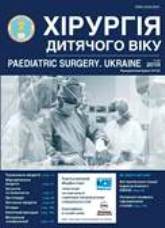Good fixation of trocar: is it necessary for endoscopic operations?
DOI:
https://doi.org/10.15574/PS.2018.60.73Keywords:
trocar, subcutaneous emphysema, children, malformations, laparoscopy, thoracoscopy, lumboscopy, vesicoscopyAbstract
Laparoscopic surgery has become the «gold standard» in the treatment of most surgical diseases and malformations in children. However, slipping out of the trocar sleeve during instrument changing, especially in infants, remains a problem.
Objective: to develop and implement a rapid and atraumatic fixation of trocar in the patient's soft tissues during the endoscopic operations in children.
Materials and methods. In total 53 endoscopic operative techniques were studied in children operated on oesophageal atresia, diaphragmatic hernia, duodenal atresia, hiatal hernia, hydronephrosis, vesicoureteral reflux, and bladder diverticulum. The average duration of surgeries was 110±15 minutes. All patients were infants. The 1st group consisted of 27 patients, in whom special fixation of the trocar during the surgical intervention was not provided, the 2nd group composed of 26 children with fixed trocar according to the developed method during the surgery.
Results. Slippage of the trocar sleeve during the instrument changing was recorded in children of the 1st group in 100%, in the 2nd group in 7.7%, which prolonged the time of surgical intervention and led to subcutaneous emphysema in 62.9% of cases in the 1st group and 3.8% in the 2nd group.
Conclusions. The lack of secure fixation of the trocar with a smooth long sleeve during the laparoscopic access can be qualified as a risk factor for complication of the operation, which reduced its efficiency and safety. The recommended trocar fixation during the endoscopic operations allows to exclude its slipping out and migration from the operating field, significantly reducing the risk of wound postoperative complications.
References
Akselrov MA. (2012). Iskusstvennyie kishechnyie svischi v abdominalnoy hirurgii u detey (sovershenstvovanie metodov formirovaniya, prognozirovanie posleoperatsionnogo techeniya, lechenie i profilaktika oslozhneniy). Omsk: 42.
Akselrov MA, Emelyanova VA, Minaev SV, Suprunets SN, Sergienko TV, Karlova MN, Kiseleva NV, Stolyar AV. (2017). Uspeshnoe primenenie torakoskopii (elongatsiya po
Fokeru i formirovanie otsrochennogo anastomoza) u rebenka s mnozhestvennyimi porokami razvitiya, odin iz kotoryih atreziya pischevoda s nepreodolimyim diastazom. Meditsinskiy vestnik Severnogo Kavkaza. 12; 2: 138–141. doi.org/10.14300/mnnc.2017.12039
Akselrov MA, Emelyanova VA, Razin MP, Sergienko TV, Suprunets SN, Akselrov AM, Kiseleva NV, Anohina IG. (2017). Pervyiy opyit provedeniya laparoskopii nedonoshennyim novorozhdennyim, stradayuschim nekrotiziruyuschim enterokolitom. Vyatskiy meditsinskiy vestnik. 2 (54): 4–6.
Akselrov MA, Emelyanova VA, Suprunets SN, Sergienko TV, Anohina IG, Kiseleva NV. (2018). Pervyiy opyit vyipolneniya laparoskopicheskogo duodeno-duodenalnogo u novorozhdennyih s vyisokoy kishechnoy neprohodimostyu, vyizvannoy koltsevidnoy podzheludochnoy zhelezyi. Novosti hirurgii. 2; 26: 248–253. doi 10.18484/2305-0047.2018.2.248
Lishko VV, Zaytsev DA. (2009). Troakar. Patent na poleznuyu model RUS 88264 10.07.2009.
Mazitov MI, Lyapahin AB, Alyiev ShA. (2008). Ustroystvo dlya laparoskopii. Patent na izobretenie RUS 2375976 30.06.2008.
Rusak PS, Voloshin YuL. (2016). Miniinvazivnyie metodyi diagnostiki i lecheniya abdominalnoy formyi kriptorhizma. Meditsinskaya nauka i zdravoohranenie Urala. 3 (87): 22–26.
Tolstanov OK, Danylov OA, Rusak PS, Rybalchenko VF, Zaremba VR, Shevchuk DV, Voloshyn YuL. (2012). Osoblyvosti likuvannia abdominalnoi formy kryptorkhizmu. Khirurhiia dytiachoho viku. 3: 34-38.
Fedorov IV, Chugunov AN, Viliullin IN. (2009). Profilaktika troakarnyih oslozhneniy v laparoskopii. Endoskopicheskaya hirurgiya. 15; 6: 54–56.
Shinkarev SA, Podolskiy VN, Sinitsyin YuI, Korenev AA, Pikalov OA, Kozlovskaya EV, Harin DV, Pripachkin SA, Zaytsev IG, Bobrovskiy AV. (2010). Troakar s naruzhnoy i vnutrenney atravmatichnoy fiksatsiey dlya endoskopicheskih operatsiy. Patent na izobretenie RUS 2428945 19.05.2010.
Abdellaoui A, Atwan M, Reid F et al. (2007). Endoscopic assisted transaxillary first rib resection. Interact CardioVasc Thorax Surg. 6: 644–646. https://doi.org/10.1510/icvts.2007.151423; PMid:17670741
Bax NMA, van der Zee DC. (2002). Feasibility of thoracoscopic repair of esophageal atresia with distal fistula. J Pediatr Surg. 37: 192–196. https://doi.org/10.1053/jpsu.2002.30253; PMid:11819197
Holcomb GW, Rothenberg SS, Bax MA et al. (2005). Thoracoscopic repair of esophageal atresia and tracheoesophageal fistula: A multi-institutional analysis. Annals of Surgery. 242; 3: 422–30. PMid:16135928 PMCid:PMC1357750
Shepard AD, Parikshak M. (2004). Current surgical therapy. J Cameron (editor). Elsevier and Mosby: 840-845.
Downloads
Issue
Section
License
The policy of the Journal “PAEDIATRIC SURGERY. UKRAINE” is compatible with the vast majority of funders' of open access and self-archiving policies. The journal provides immediate open access route being convinced that everyone – not only scientists - can benefit from research results, and publishes articles exclusively under open access distribution, with a Creative Commons Attribution-Noncommercial 4.0 international license(СС BY-NC).
Authors transfer the copyright to the Journal “PAEDIATRIC SURGERY.UKRAINE” when the manuscript is accepted for publication. Authors declare that this manuscript has not been published nor is under simultaneous consideration for publication elsewhere. After publication, the articles become freely available on-line to the public.
Readers have the right to use, distribute, and reproduce articles in any medium, provided the articles and the journal are properly cited.
The use of published materials for commercial purposes is strongly prohibited.

